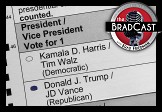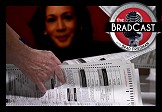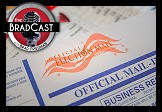After requiring Alaska's GOP U.S. Senate candidate Joe Miller to file his federal lawsuit by Monday (yesterday), the federal judge in the case has now dismissed it without even waiting for the reply from the state, which was ordered due by Wednesday (tomorrow).
 From Anchorage Daily News as posted within the last hour...
From Anchorage Daily News as posted within the last hour...
She's now scheduled to be sworn in for a new six-year term on Jan. 5.
U.S. District Judge Ralph Beistline issued a 14-page order this afternoon in which he said Miller wasn't raising any federal issues that he needed to resolve. He ordered Miller's entire federal case dismissed.
Beistline wrote that he would not second guess the Alaska Supreme Court, which already had ruled against Miller.
...
Miller said in a statement that he was disappointed by today's ruling and thought the U.S. Constitution's election clause presented a significant federal issue.
"Specifically, should the courts be required to follow the legislature's standard for the selection of U.S. Senators or create their own?" Miller said in a written statement. "My legal team believes that the clear language of the Election Clause as well as precedent support our claims. Thus, we are evaluating the ruling and determining what our next step should be."
...
The judge said state lawyers didn't need to respond to Miller's latest filings in federal court. But he also said Miller's technical arguments were not frivolous.
...
"What we have before us is a poorly drafted state statute," Beistline wrote. "Wisdom would suggest that the Alaska Legislature act to clarify it to avoid similar disputes in the future. For now we have to work with what we have and that is what the Alaska Supreme Court has done."
Last night we published our detailed analysis of Joe Miller's federal complaint, in which he pointed out Constitutional questions about the way in which the Diebold optical-scan system was used to tally votes. We also pointed out what might have been a fatal flaw in his complaint. Whether Miller will appeal Beistline's decision remains to be seen.
Beistline's 14-page dismissal is here [PDF].
UPDATE 8:22pm PT: A few thoughts after reading Beistline's dismissal...
To break down the judge's ruling, there were three counts he needed to respond to (as we detailed last night), each one included an allegation by Miller of a Constitutional violation. I'll do my best to quickly recap each count and Beistline's reasoning for dismissing each:
I. THE ELECTIONS CLAUSE (COUNT ONE)
Here Miller argued that Article 1, section 4 of the Constitution requires each state legislature to determine the "manner" of electing its representatives to Congress, and the legislature had done that in Alaska through their specific statutes which include how write-in ballots are to be counted. But, he argued, the state executive branch essentially overrode the legislature's Constitutionally mandated role when the Lt. Governor, who oversees the state Division of Elections (DOE), gave the DoE authority to determine "voter intent" of write-in ballots, even where the strict state statutes require exact spelling, and "no exceptions" to the requirements specified in the election code.
Beistline's dismissal of this count was the most curious, at least upon my first, quick reading. Here's the key portion:
What we have before us is a poorly drafted state statute. Wisdom would suggest that the Alaska Legislature act to clarify it to avoid similar disputes in the future. For now we have to work with what we have and that is what the Alaska Supreme Court has done.Generally speaking, the Alaska Supreme Court is the final expositor of Alaska law. That must be the case here. It concluded that Miller's interpretation of the statute "would erode the integrity of the election system," and held that "voter intent is paramount." Under the facts presented, this Court declines to second-guess the highest Court of the state.
...
The process for counting the write-in ballots is constitutional under the Elections Clause, because it complies with the Alaska Supreme Court's interpretation of the relevant statutory language. Therefore, Plaintiff’s claim under the Elections Clause fails.In other words, Beistline seems to be saying, the Alaska Supreme Court found the use of "voter intent" (rather than a strict reading of the statute) to be in compliance with the law, therefore, there is no Constitutional issue here. That strikes me as odd, but I'm not an attorney. The whole point of a federal case such as this, arguing Constitutional issues, is because the plaintiff, in this case Miller, finds an unconstitutional interpretation of law in his state. That the AK Supremes found the DoE's interpretation to be legal under state law hardly seems an argument for the constitutionality of their interpretation. But again, I'm not an attorney.
For the record, had the judge found for Miller here, it might have led to the disenfranchisement of thousands of voters who had misspelled Lisa Murkowski's name on their write-in ballot. In my opinion (and in that of the AK Supreme Court) "voter intent" should, indeed, be "paramount". But the language of the statute in question (AS 15.15.360) is very specific in its explanation of which ballots may be counted as valid, and goes on to explicitly decree: "The rules set out in this section are mandatory and there are no exceptions to them. A ballot may not be counted unless marked in compliance with these rules."
So while tossing out thousands of ballots for minor spelling issues may be a rather abhorrent idea, at least to me (and the state, in this case) I'd agree with Beistline that the state legislature needs to act to clarify those rules. Despite that, however, it doesn't seem as if Beistline was responsive to the Constitutional question here of whether or not the executive branch, via the Lt. Gov and the DoE, had the right to, essentially, override the legislative branch's Constitutionally mandated determination of the "Manner of holding Elections for Senators and Representatives" as reflected by their election statutes.
II. THE EQUAL PROTECTION CLAUSE (COUNT TWO - VOTER INTENT STANDARD)
In this count, Miller alleged that the DoE's attempt to divine "voter intent" to determine validity of the ballot was entirely too vague. The Constitution's Equal Protection Clause requires "specific standards" and "uniform rules" which were lacking in this case, he argued, citing Bush v. Gore as precedent, and the state's attempt to determine "voter intent" was "vague, amorphous, subjective."
In response, Beistline wrote:
The factual situation in this case differs significantly from that in Bush. First, the write-in ballots in this case were counted and tabulated by a single state-wide election board and the determination of challenged ballots was made by a single individual, the Director. Second, although the determination of whether to count the vote is subject to a certain degree of subjectivity, the standard itself is uniform across the board. Thus, there is little, if any, likelihood that one voter’s vote would be counted and another’s vote, with the identical characteristics, would be rejected.
...
The evaluation of handwritten ballots is markedly different from “divining the intent of a voter by scrutinizing a dimpled chad” or “interpret[ing] the marks or holes or scratches on an inanimate object.” The very nature of a “writein” vote pre-supposes a requirement that someone will have to read the handwriting and determine for whom the vote was cast. Under the circumstances presented, the Court cannot find the procedures followed by Defendants to have been unreasonable. Miller’s challenge fails.So the judge is saying that a single person determining which votes are valid and which ones aren't, keeps that decision from violating the Equal Protection clause. (He doesn't speak to whether having a single person decide such things, on a subjective basis, is a particularly bright idea, but that's how they do it in Alaska, for whatever reason, unlike in Minnesota where their excellent procedures involve a number of multi-partisan committees at different levels who vote on whether to accept or reject ballots that are challenged at the hand-counting level during a recount.)
Beistline's further argument that "voter intent" may be determined from human marks on write-in ballots, but not from human marks on punch-card ballots, is not particularly persuasive --- to me at least. But that's how he is able to separate this case from Bush v. Gore where it was found, by the U.S. Supreme Court, to be too difficult to auger voter intent from punch card ballots where the chad was not cleanly removed.
III. THE EQUAL PROTECTION CLAUSE (COUNT THREE - DISCRIMINARY POLICY REGARDING “REJECTED” BALLOTS)
In this final count, Miller argued that ballots counted by hand, as necessary to determine write-in votes, received greater weight than ballots where pre-printed candidates were selected. His reasoning, as we explained in some detail in our analysis of his complaint after it was filed last night, is largely because ballots rejected by the Diebold optical-scan systems used in Alaska were not re-examined to determine if, in fact, the computer tallied result was accurate. But rejected ballots were examined by hand to determine whether or not there was a valid write-in vote on them.
The result, Miller argued, was that ballots with write-in votes received a "second bite at the apple", whereas voters for pre-printed candidates did not and that is a violation of the Constitution's Equal Protection Clause, as per Bush v. Gore again, in that it gives greater weight to some ballots over others.
Beistline dismissed the allegation entirely, responding that Miller's factual explanation of the counting process was simply inaccurate:
Plaintiff made a similar argument under state law, which was addressed by the Superior Court Judge and by the Alaska Supreme Court. Judge Carey noted that the record reflects that division workers did actually review every ballot, not just write-in ballots, in the counting process, examining the ovals and making individual determinations of the so-called “undervote, overvote” ballots (those ballots which were rejected by the tally machines for either having too many ovals filled in or no oval filled in). See Carey Order at 19. The Alaska Supreme Court carefully examined the record and concluded that “the record does not support Miller’s contention that ballots . . . were treated differently depending on whether they were cast for candidates whose names were pre-printed on the ballot.” Accordingly, there appears to be no factual basis for this cause of action.He further rejected the idea that differing methods of counting ballots, in any case, violates the Equal Protection Clause either --- even though Bush v. Gore, at least to my memory, was pretty clear on that --- largely, it seems, because no other court has found that to be the case:
In short, “[n]o court has held that the mere use of different methods of counting ballots constitutes an equal protection violation.” This Court finds that even if the record reflected only a machine count of Miller’s votes and a hand-count of write-in votes, it is not an action that rises to the level of an Equal Protection violation.Given that differing voting machines have differing rates of counting errors (though that was not argued by Miller in this case), it's disturbing to see Beistline's finding here that ballots can be counted by all manner of differing machines --- presumably even in the same county --- and it would make no difference at all, at least not as far as the Equal Protection Clause is concerned.
I've updated the initial text from the Anchorage Daily News above, to reflect their addition of Miller's response to the news, which is as follows:
So it seems he's weighing his options for an appeal here, and seems to be focusing on Count One, as detailed above, where it does seem as if the judge didn't even bother to address the Constitutionality of the question. I've got a call in to Miller and will update this item with any noteworthy details if/when I hear back from him.
The fact that Beistline dismissed the case in full, even before the state's response, and "even without a motion to dismiss pending, he just did it on his own (sua sponte)", as one Alaska source familiar with state law noted tonight, is also interesting. If any legal eagles out there has any thoughts on that, I'd love to hear from you in comments.
If Miller chooses to press on with his case, the next stop would be the 9th Circuit Court of Appeals.


 Former Federal Prosecutor: Trump Must Be Sentenced in NY Before Taking Office Again: 'BradCast' 11/20/24
Former Federal Prosecutor: Trump Must Be Sentenced in NY Before Taking Office Again: 'BradCast' 11/20/24 'Bullet Ballot' Claims, Other Arguments for Hand-Counting 2024 Battleground Votes: 'BradCast' 11/19/24
'Bullet Ballot' Claims, Other Arguments for Hand-Counting 2024 Battleground Votes: 'BradCast' 11/19/24 'Green News Report' 11/19/24
'Green News Report' 11/19/24
 Trump Already Violating Law (He Signed!) During Transition: 'BradCast' 11/18/24
Trump Already Violating Law (He Signed!) During Transition: 'BradCast' 11/18/24 Sunday 'Into the Gaetz of Hell' Toons
Sunday 'Into the Gaetz of Hell' Toons Computer Security Experts Ask Harris to Seek Hand-Counts Due to Voting System Breaches: 'BradCast' 11/14/24
Computer Security Experts Ask Harris to Seek Hand-Counts Due to Voting System Breaches: 'BradCast' 11/14/24  'Green News Report' 11/14/24
'Green News Report' 11/14/24 Trump Criminal Cases Fade After Election as GOP 'Does Not Believe in Rule of Law': 'BradCast' 11/13/24
Trump Criminal Cases Fade After Election as GOP 'Does Not Believe in Rule of Law': 'BradCast' 11/13/24 Climate Advocates Brace for Fight With Trump 2.0: 'BradCast' 11/12/24
Climate Advocates Brace for Fight With Trump 2.0: 'BradCast' 11/12/24 'Green News Report' 11/12/24
'Green News Report' 11/12/24 Let It All Out: 'BradCast' 11/11/24
Let It All Out: 'BradCast' 11/11/24 Sunday 'Like it or Not' Toons
Sunday 'Like it or Not' Toons Not All Bad: Abortion Rights Won Big (Almost) Everywhere: 'BradCast' 11/7/24
Not All Bad: Abortion Rights Won Big (Almost) Everywhere: 'BradCast' 11/7/24 'Green News Report' 11/7/24
'Green News Report' 11/7/24 U.S. CHOOSES CONVICTED CRIMINAL, ADJUDICATED RAPIST: 'BradCast' 11/6/24
U.S. CHOOSES CONVICTED CRIMINAL, ADJUDICATED RAPIST: 'BradCast' 11/6/24 ELECTION DAY 2024: Tea Leaves, Probs for Voters, What's Next: 'BradCast' 11/5/24
ELECTION DAY 2024: Tea Leaves, Probs for Voters, What's Next: 'BradCast' 11/5/24 'Closing Arguments' for Undecideds, Third-Party Voters: 'BradCast' 11/4/24
'Closing Arguments' for Undecideds, Third-Party Voters: 'BradCast' 11/4/24 The GOP 'Voter Fraud' Before the Storm: 'BradCast' 10/31/24
The GOP 'Voter Fraud' Before the Storm: 'BradCast' 10/31/24 'Closing Arguments'with Digby and Driftglass: 'BradCast' 10/30/24
'Closing Arguments'with Digby and Driftglass: 'BradCast' 10/30/24 Trump Promises to be a Lawless, Authoritarian President. Believe Him: 'BradCast' 10/29/24
Trump Promises to be a Lawless, Authoritarian President. Believe Him: 'BradCast' 10/29/24 Ballots Burn, Billion-aires 'Obey in Advance', Callers Ring In: 'BradCast' 10/28/24
Ballots Burn, Billion-aires 'Obey in Advance', Callers Ring In: 'BradCast' 10/28/24 Musk's Privatized Internet Satellite System Threatens U.S. National Security
Musk's Privatized Internet Satellite System Threatens U.S. National Security
 VA GOP VOTER REG FRAUDSTER OFF HOOK
VA GOP VOTER REG FRAUDSTER OFF HOOK Criminal GOP Voter Registration Fraud Probe Expanding in VA
Criminal GOP Voter Registration Fraud Probe Expanding in VA DOJ PROBE SOUGHT AFTER VA ARREST
DOJ PROBE SOUGHT AFTER VA ARREST Arrest in VA: GOP Voter Reg Scandal Widens
Arrest in VA: GOP Voter Reg Scandal Widens ALL TOGETHER: ROVE, SPROUL, KOCHS, RNC
ALL TOGETHER: ROVE, SPROUL, KOCHS, RNC LATimes: RNC's 'Fired' Sproul Working for Repubs in 'as Many as 30 States'
LATimes: RNC's 'Fired' Sproul Working for Repubs in 'as Many as 30 States' 'Fired' Sproul Group 'Cloned', Still Working for Republicans in At Least 10 States
'Fired' Sproul Group 'Cloned', Still Working for Republicans in At Least 10 States FINALLY: FOX ON GOP REG FRAUD SCANDAL
FINALLY: FOX ON GOP REG FRAUD SCANDAL COLORADO FOLLOWS FLORIDA WITH GOP CRIMINAL INVESTIGATION
COLORADO FOLLOWS FLORIDA WITH GOP CRIMINAL INVESTIGATION CRIMINAL PROBE LAUNCHED INTO GOP VOTER REGISTRATION FRAUD SCANDAL IN FL
CRIMINAL PROBE LAUNCHED INTO GOP VOTER REGISTRATION FRAUD SCANDAL IN FL Brad Breaks PA Photo ID & GOP Registration Fraud Scandal News on Hartmann TV
Brad Breaks PA Photo ID & GOP Registration Fraud Scandal News on Hartmann TV  CAUGHT ON TAPE: COORDINATED NATIONWIDE GOP VOTER REG SCAM
CAUGHT ON TAPE: COORDINATED NATIONWIDE GOP VOTER REG SCAM CRIMINAL ELECTION FRAUD COMPLAINT FILED AGAINST GOP 'FRAUD' FIRM
CRIMINAL ELECTION FRAUD COMPLAINT FILED AGAINST GOP 'FRAUD' FIRM RICK SCOTT GETS ROLLED IN GOP REGISTRATION FRAUD SCANDAL
RICK SCOTT GETS ROLLED IN GOP REGISTRATION FRAUD SCANDAL VIDEO: Brad Breaks GOP Reg Fraud Scandal on Hartmann TV
VIDEO: Brad Breaks GOP Reg Fraud Scandal on Hartmann TV RNC FIRES NATIONAL VOTER REGISTRATION FIRM FOR FRAUD
RNC FIRES NATIONAL VOTER REGISTRATION FIRM FOR FRAUD EXCLUSIVE: Intvw w/ FL Official Who First Discovered GOP Reg Fraud
EXCLUSIVE: Intvw w/ FL Official Who First Discovered GOP Reg Fraud GOP REGISTRATION FRAUD FOUND IN FL
GOP REGISTRATION FRAUD FOUND IN FL


































